Snooker
Snooker (British: [ˈsnuːkə]) is a variation of the precision sport of billiards.
Snooker is played on a snooker table covered with a worsted cloth. It is bordered on each side by a cushion in which a total of six pockets are embedded. At the beginning of a round there are 22 billiard balls on the table: 21 object balls and the cue ball. The cue ball is hit with the cue. Ideally, it touches an object ball so that it runs into one of the six pockets. The player receives points for punching a ball: the 15 red balls are worth one point each, the other object balls have ascending scores (yellow → 2, green → 3, brown → 4, blue → 5, pink → 6, black → 7). At the start of a shot, called a break in snooker, one of the reds must be played. If this is successfully holed, one of the other balls follows, then one of the remaining reds and so on. Unlike the reds, the other balls are each returned (to their starting position) to the table. Finally, a round ends with the final game on the colors, where the remaining balls ("colors" as they are called) are final holed in ascending order. So, ideally, you can score 147 points with one break.
A shot also ends if a ball is not holed with a shot or a violation of the rules is committed. In these cases, the opponent can start a shot. The round, called a frame in snooker, ends either when all the object balls have been pocketed or when a player has given up. The winner of the frame is the player with the most points. An entire game usually consists of several frames. Elementary components of the game are technique and tactics. Besides posture and concentration, you can also gain advantages during the game. This is possible by offensive or defensive shots or game situations, for example split, safety and snooker. Defensive kicks such as safety and snooker are aimed at forcing the opponent to break the rules. Such a foul results in points for the other player. To solve difficult game situations, the player has several types of auxiliary cues available in addition to different types of shots.
Developed in the second half of the 19th century in British India, snooker became popular in the United Kingdom at the beginning of the 20th century. In 1927 the first snooker world championship was held. Until well into the 1960s, brothers Joe and Fred Davis and John Pulman dominated the sport. The sport revived after a period of stagnation with the inclusion on BBC programming and the formation of the WPBSA. With increasing popularity and profitability, the number of professional players increased significantly. In the 21st century, the progressive globalization of the sport followed in and after a period of mismanagement. Among the most notable players since the 1970s are multiple world champions Ray Reardon, Steve Davis, Stephen Hendry and Ronnie O'Sullivan. Today, snooker is mainly popular in the United Kingdom and the People's Republic of China and is therefore received in the media and to a lesser extent artistic-cultural. In the D-A-CH area snooker is despite some good players and important tournaments a marginal sport. Apart from the normal snooker, there are also some snooker variants such as the Six-Red-Snooker.
_2012-02-05_28.jpg)
Snooker table to start frame
Game Material
Snooker table
→ Main article: Snooker table
Snooker tables come in different sizes, but professionally 12-foot tables are used. Generally, the tables are twice as long as they are wide. The professional tables have an area of about 366 × 183 centimeters at the outer edge, the inner surface is then about 357 × 178 centimeters. With a height of about 85 to 86 centimetres, the table has a total weight of about 1.5 tons. The playing surface consists of a 4.5 to 6 centimetre thick slate plate on which a green worsted cloth is stretched. Nowadays it is common to heat the playing surface because of some positive effects. The playing surface is surrounded on each side by boards made of a special elastic rubber. They are also covered with the worsted cloth and ideally enable an "even and dynamic tee shot" after contact with the ball. This effect can be increased by integrated steel bands. At each corner as well as in the middle of each long side the bands are interrupted by the pockets, which have a different shape compared to the pool table and are therefore more difficult to hit. The legs of the table are made of oak or mahogany.
There are various white markings on the snooker table. 737 millimeters below the foot band it is a solid line, the so-called Baulk line. It has only limited significance in snooker and comes from English Billiards. In the middle of the Baulk line is a semicircle with a radius of 292 millimeters, the so-called D. From the area within the D at the beginning of a frame or in a "ball in hand" the cue ball is played out. In addition, there are three spots on the baulk line within the D, two at the beginning and end of the semicircle and one in the middle of the other two. From left to right, these are the marks for the colors yellow, brown, and green. There are also three more touchdown marks: for the blue ball in the middle of the table, for the pink ball in the middle between the blue and the head rail, and for the black ball 324 millimetres above the head rail. Below the touchdown mark for pink, the fifteen reds are arranged in a triangle shape.
Cue
→ Main article: Cue (billiards)
The cue is the playing device in snooker. It is basically a pointed wooden stick. Especially for regular players, the performance of the player also depends on the use of a particular cue. Since cues differ in subtleties, they suit a player's playing style differently. Losing or damaging the cue you are used to can possibly lead to a noticeable loss of performance for professional players. The cue is a wooden stick weighing 450 to 490 grams and 140 to 150 centimeters long. The minimum length is 91.4 centimeters, but the optimal length is usually in this range and depends on the height of the player. For the upper part of the cue mainly ash wood is used, more rarely also maple wood, because ash is comparatively hard and stable and offers a good swinging behaviour. The grip area, on the other hand, is often made of ebony for reasons of aesthetics and balance. Lacquering, decorations and inlays are detrimental to stability as well as grip. Most cues can be disassembled into two or three pieces for ease of transport. To protect the cue during transport, professional players in particular use special containers to minimize the risk of damage. For transport and storage, a division in the middle of the cue is best for two-piece cues, but in comparison to a division into three quarters and one quarter (¾ top, ¼ handle) it is worse in terms of impact feeling. Apart from that there are different extensions which can be screwed on the handle.
Ferrule and bitter orange
At the upper end the cue is closed by the ferrule, a part mostly made of brass. On the ferrule is a small leather plate attached, the so-called Pomeranze. The pomerance is supposed to guarantee a more controlled stroke. It is convexly curved and therefore only touches the ball with as small an area as possible. In addition, the surface of the bitter lance should be as rough as possible in order to create a better grip on contact with the ball. The diameter of the Pomeranze is related to that of the cue, but is on average 9 to 11.5 millimeters and is thus smaller than its counterpart in pool; there, the cue tips are larger than in snooker because of the larger balls. There are bitterances made of hard leather and bitterances made of soft leather; both variations have special subtleties and are of a certain importance for the snooker game of the individual. In addition, there are both Pomerances that overlap the edge of the cue and those that end together with the cue. While the use of a particular type of Pomeranze is a matter of taste, some players feel they can control the ball better with an overlapping Pomeranze. Generally speaking, the Pomeranze is a consumable item that can be maintained to some extent by certain means, but it must be replaced after a certain period of time. The time period depends among other things on the impact hardness.
The Pomeranze is chalked with a special billiard chalk, which should improve the adhesion at impact. Depending on the quality, the chalk is more or less grippy; the more completely the bitter lance is chalked, the better the effect. It can be optimised by chalking the bitter lance in a rotating manner. In general, the turquoise to green chalk used in snooker is less greasy than in pool and less dirty, but the chalk must be chalked more often. In addition to this common chalk, there is another commonly used type of chalk, called Taom chalk, which is round, unlike the normal chalk. It is supposed to reduce kicks, but increases the probability that the cue tip slips off the cue ball.
Auxiliary cues
In addition there are some auxiliary cues which should simplify the playing in certain situations. The auxiliary cues are an additional support or shelf for the cue during the shot. Altogether there are five of these auxiliary cues, which generally belong to the equipment of a snooker table. The end of the auxiliary cue is held firmly in the hand and the forearm horizontally, so that the body posture is rather sideways and therefore different than in the auxiliary cue-less game. The most common is the "cross", which has an X attached to the tip. It is used by placing the cue in one corner of the cross. Depending on the position of the auxiliary cue, the cue ball can be played higher or lower with it. In other situations - for example when playing over an interfering ball - the "spider" is also used. There are three variations of the spider, sometimes also called "bridge". Each variant has a ring at the front with different supports for the cue; in the case of the "extended spider" this ring is shifted forward. When used, however, the cue ball is hit more steeply than usual. In similar cases as the spider the "gooseneck" is used, where you hit the ball even steeper and where you can also easily slip with the cue. In addition, there was also a new type of auxiliary cue, the "hookrest", which was bent in the middle in addition to the normal X at the front, in order to be able to avoid interfering balls. In spite of the simplification of the game this cue did not prevail, because the bypassed balls disturbed the guidance of the main cue.
· 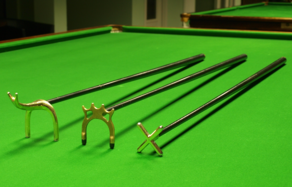
"Gooseneck," "Spider" and "Cross"
· 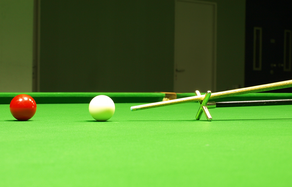
The "cross"
· 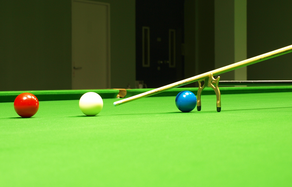
The "Spider"
· _2012-02-05_07.jpg)
The "extended spider"
· 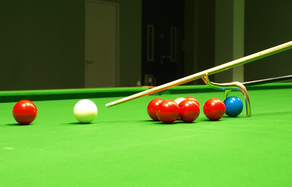
The "Gooseneck"
Balls
→ Main article: Billiard ball
In snooker, there are a total of 22 balls; in addition to the cue ball and the 15 reds, one ball each in yellow, green, brown, blue, pink and black. The balls were made over time from a variety of materials: so they were originally made of stone or leather and later of metal, ivory or bone. However, this had the disadvantage that the mass of the ball was not evenly distributed and the centre of gravity could therefore deviate from the desired centre of gravity in the middle of the ball. This could cause the ball to tilt to one side in the barrel during slow impacts and therefore make the impact more difficult. After an attempt in 1870 to use billiard balls made of celluloid, special synthetic materials such as phenolic resin are now used, whereby the mass of the balls is optimally distributed and they also have a high stability. The diameter of each ball is approximately 52.5 millimetres; a tolerance of ± 0.05 millimetres is possible. Thus, the snooker ball is significantly smaller than a billiard ball in pool or carom billiards. In addition, the snooker ball with a weight of 142 grams is also lighter than other billiard balls; here a tolerance of ± 3 grams is allowed in the entire set. Usually the manufacturer guarantees for sets intended for professional snooker that the lightest and heaviest ball do not differ from each other by more than one gram. Apart from this, the cleanliness of the ball is also important; the cleaner the ball, the less likely it is to be kicked. A ball is generally cleaned with a cloth made of microfiber or lint-free cotton, and there are also various special cleaning agents.

Billiard chalk (left) and cue (right) with ferrule (gold) and bitter lance (blue)
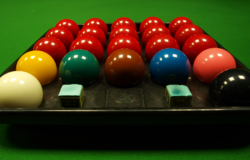
A set of snooker balls
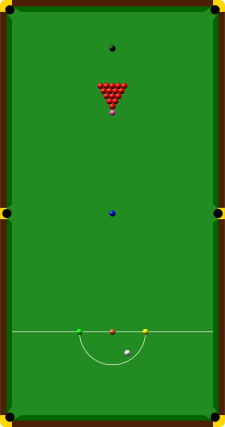
Graphic of a snooker table with the balls on top; below the foot rail, above the head rail

Cue with extensions
Engineering
The body position during a thrust is designed to give the body stability. There are three centres of gravity with the two legs and the lead hand, whereby the lead hand is the hand of the slightly bent arm with which the kick is not made. The latter is done by the other arm, the so-called push arm. Ideally, the upper arm is perpendicular to the lower arm, runs parallel to it above the cue and has room for the shot or for swinging, while the leg on the same side of the body is perpendicular to the ground and pressed through. During the stroke the upper body is bent forward with the head above the cue and the chin resting on the cue. Nearly above the cue is the guide eye, with which the object ball to be hit is aimed. The hand of the shooter grasps the upper end of the cue as an extension of the forearm; the stronger or longer the shot, the further back. The guide hand stabilizes, whereby one differentiates depending upon situation and hand attitude between different kinds, which can be divided basically into the "open buck" with the stretched out fingers at the table and the "closed buck" with the ball of the hand at the table. In addition there is the "buck over a ball", where you can guide the cue over a ball by bending the wrist upwards, which is also called "overhand", as well as a form of the buck especially for the rail.
Elementary important is a high concentration during the game, especially when planning the break and especially during the respective shot. Especially in professional snooker the concentration or the mental strength is decisive for the game. The shot itself begins with a swing of the forearm, which is followed by the retraction of the cue to the jab or buck hand. The shot is followed by an accelerated forward movement of the forearm together with the cue. Depending on how far the cue is moved and at what speed, a distinction is made between short, slow and long, fast kicks. The longer a shot, the longer the shot; long shots are also used to execute follow-ups and returns, whereas short shots are used to execute stop balls. These three types of shots, in which the cue ball "follows up" after contact with the object ball, "runs back" again or "stops" following contact, also serve to control the cue ball and thus position play. For all three balls, one varies the point of contact between the cue and the cue ball, which means that the cue no longer hits in the centre of the cue ball, but in the case of a stop ball slightly below, in the case of a trailing ball above and in the case of a return ball (incidentally also called a draw ball) further below than in the case of the stop ball. In addition, a head shot and especially a massé shot are possible, as they are mainly used in carom billiards. Here, besides the risk of damaging the cloth on the table, there is also a certain risk regarding the success of the shot. Furthermore, trick shots are theoretically possible, but practically not allowed in official snooker. In addition, to the position game also the Effet is used; here the cue ball is not (only) vertically offset hit in contrast to the stop ball, after and return, but (also) horizontally offset from the center of the cue ball. As a result, the cue ball itself rotates and thus drifts more to the side on which the cue ball was hit. In addition, by varying the impact speed, the placement position of the cue ball can be influenced.
Another term around the execution of the shot is the term kick, which describes an unclean contact between the cue ball and the object ball, mainly caused by dirt on the ball. Such a kick usually has a counterproductive effect on the path of the object ball and the cue ball and is therefore avoided. In a hole attempt, ideally the kicked cue ball hits the object ball, i.e. the ball to be holed, at a point from which a straight line can be drawn through the object ball to a pocket. This line also represents the path of the ball. The closer an object ball is to the pocket, the easier it is to punch, as there is now a certain margin of accuracy; if there is a deviation from the ideal case, the object ball may fall sooner the closer it is to the pocket. A special case are combination shots, where a successful punch is attempted by a combination of two object balls. The cue ball hits one of the two object balls in such a way that it touches the other object ball so that it falls into a pocket. In order to open up the crowd of reds at the beginning of the frame and thus open up more possibilities, the so-called split is also an important part of the technique. With the split primarily a color, mostly black or blue, is punched, but after that the cue ball still runs into the bunch of reds and thus opens it. If an object ball is close to a cushion, it is generally only pierced with a shot "over (a) cushion", whereby the cue ball plays the object ball against the cushion and this is then ideally pushed off so that it runs into a pocket on the opposite side.
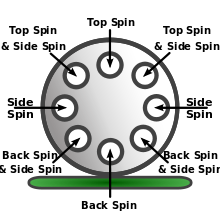
The different possibilities with the Effet (english)
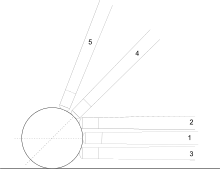
The different types of impact: 1. normal impact2 . trailing impact3 . Return shot4 . Jump shot (trick shot) 5. head butt / massé butt
_2013-01-30_15.jpg)
John Higgins in the bump stance: bump hand on the left, lead hand on the right (2013).
Search within the encyclopedia